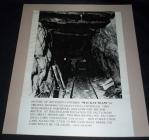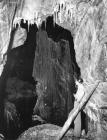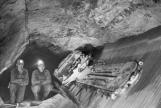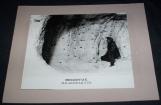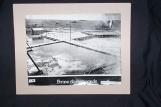14
Salt was mined from 110 feet below the surface to 1,250 feet below. The travelled distance at an average of about 40 degrees, was over 2,800 feet. Three hoists were used to get the salt to the surface and someone christened the system "A mechanical bucket brigade".Everyone working in the Mine at Malagash became a Mountain Climber. Instead of stairs there were ladders (and they were numerous) in many stopes a 3/4 " rope would be hanging and this rope was the sole means of elevating or lowering oneself. Sneakers or running shoes were excellent for clinging to the steep walls but when hard-toed boots became a safety feature the canvas shoes had to go.
16
This photo shows the steeply pitched MacKay Seam at 186 feet, with two men shovelling salt into cars. These were then pushed along the the yard rails where they were unloaded.18
Inside the Malagash Salt Mine in 1951.20
This photo shows salt crystals in the Malagash Salt Mine. The miner shown gives us a perpective as to the size of the formations.22
MINING THE SALT - UndercuttersUndercutters came into prominent use in Scottish coal mines during World War I. An undercutter is a chain saw driven by an electric motor.
The Samson cutter at Malagash came down from Glasgow and soon the Malagash boys mastered the wonderment.
It was not long before the cutters were cutting a face that was standing vertically.
It is not exagerrating to say that the manufactures came to Malagash to see what their machine could do. A Goodman Cutter (Chicago) was purchased later in 1935.
Potential cutter purchasers came from as far away as India to see undercutters work in salt. The stoping system worked this way. The main slope followed a large roll in the Lucas Seam. It would be developed when the need arose, and the new level 5' wide by 7' high would be driven a considerable distance say 1,000 feet horizontally, and then a raise 5 feet square would follow the salt up to the old level. Then commencing on the old level 7 foot holes were drilled downward, and they blasted salt into the 5 foot square raise; and then the broken rock salt was trammed out in two ton cars to the slope to be transferred to the skip, to be hoisted to surface. The 5 foot square raise (chimney) as much as 150 feet long (tall) would become a huge cavity 150 feet high by probably 200 feet laterally and 10' to 15' thick. Standing at the top of such a cavity with electric lights at the bottom one saw wonderful erie scenery.
24
MINING THE SALT - DrillsEarly in the life of the Mine, Seraton Electric, (220 Volt D. C.) auger type drills were used to drill holes in the salt to receive explosives.
By the end of World War II, almost all drilling was done by pneumatic drills. A 500 C.F.M. compressor was purchased from Seal Harbour Gold Mines, among with other items, early in World War II, and air lines ran into every slope. Plastic pipe revoluntionized transporting compressed air into too far off slopes the last years the mine produced.
26
An extract from an interview with Kenny Wilson. Kenny is speaking about his work on the core drill.So basically it was like a lot of places today, you know they lay off and hire on again, was it seasonal for a fair bit of the time, or would you become full time there after you had been there after a few years?
It became full time after? er?they hired me on the core drill to go around Nova Scotia looking for salt, because the seam here of salt we had to follow it; and after so many years of mining it had become very costly to bring the salt to surface. They had to have different hoists and everything underground. We couldn't take any big equipment underground, the seams were so crooked, drifts went in different directions, down hill and up hill. And after a while, about 1954, it cost pretty near as much to get the salt up as you could get for it. That and the railroad prices were going up all the time.
